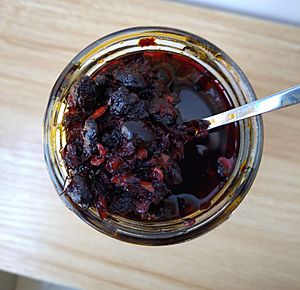Lao Gan Ma facts for kids
 |
|
| Alternative names | LAOGANMA |
|---|---|
| Type | Chili sauce |
| Place of origin | Guizhou, China |
| Created by | Tao Huabi |
| Invented | 1984/1996 |
| Main ingredients | Chili peppers |
| Lao Gan Ma | |||||||||
|---|---|---|---|---|---|---|---|---|---|
| Simplified Chinese | 老干妈 | ||||||||
| Traditional Chinese | 老乾媽 | ||||||||
| Literal meaning | old godmother | ||||||||
|
|||||||||
Lao Gan Ma (Chinese: 老干妈), also known as Old Godmother, is a famous brand of chili sauces from China. These sauces are popular in China and in over 30 other countries around the world. Lao Gan Ma is known for helping to make Chinese chili oil and chili crisp popular in Western countries. It has even inspired many chili toppings in American Chinese cuisine.
Contents
The Story of Lao Gan Ma
The story of Lao Gan Ma began with a woman named Tao Huabi. People say she first created her special sauce in 1984. In 1989, she opened a noodle restaurant in Guiyang, a city in Guizhou, China.
Tao Huabi noticed that her customers really loved her hot sauces. Because of this, she decided to change her restaurant into a special shop just to sell her sauces. Her chili oil sauce was especially popular. In 1994, she started a small factory to make her sauces. She borrowed two buildings and hired 40 people to help her.
Growing the Business
The Lao Gan Ma brand quickly became very successful. Tao Huabi is the owner of the company. Her son, Li Guishan, became the first president of the company. By 2011, the company was worth a lot of money, about 1.3 billion yuan (which was about US$190 million back then). It also had 2,000 employees. The company that makes the sauce, Laoganma Special Flavour Foodstuffs Company, was officially started in 1997. By 2022, Lao Gan Ma sauces were easy to find in many places outside of China.
Dealing with Challenges
Even though the brand was very popular, it faced some challenges. Other companies sometimes tried to copy Lao Gan Ma's packaging and name. This made it hard for customers to know which product was the real one.
In 2001, a court in Beijing decided that other products could not use the "Lao Gan Ma" name or copy its packaging. Tao Huabi received money as a result. The company finally got its official trademark in 2003 after a long legal process. This helped protect the brand from being copied.
A Change in Recipe?
After 2016, Lao Gan Ma's sales in China went down for two years. Some people thought this happened because the recipe might have changed in 2011. It was said that after Tao Huabi's son took over, the company started using a different type of chili pepper.
Originally, Lao Gan Ma used chilies from Guizhou. These chilies are big and have a lot of water, which makes them good for hot sauce. They also give the sauce a special smell, not just a spicy taste. Some people felt that the sauce lost its unique flavor when the company switched to chilies from Henan. In 2019, Tao Huabi returned to manage the company. Lao Gan Ma then switched back to using Guizhou chilies, bringing back the original taste.
A Misunderstanding with Tencent
In 2019, a tricky situation happened involving Lao Gan Ma and a big technology company called Tencent. Some individuals pretended to be from Lao Gan Ma and signed a fake agreement with Tencent. This agreement was about advertising for a video game called SpeedDrifters.
Tencent thought Lao Gan Ma owed them money for advertising. They tried to get the payment many times but didn't get a response. In April 2020, Tencent asked for some of Lao Gan Ma's money to be held until the issue was sorted out. Lao Gan Ma then found out that someone had used a fake company seal to create the false agreement. By July 2020, the people who caused the problem were identified. Lao Gan Ma and Tencent then worked together and solved the misunderstanding.
What Kinds of Sauce Are There?
Lao Gan Ma makes many different flavors of chili sauce. Some popular ones include Spicy Chili Crisp, Chili Oil with Black Bean, Fried Chili in Oil, Hot Chili Sauce, and Spicy Bean Paste. These products are based on traditional chili sauces from Guizhou cuisine.
See also



